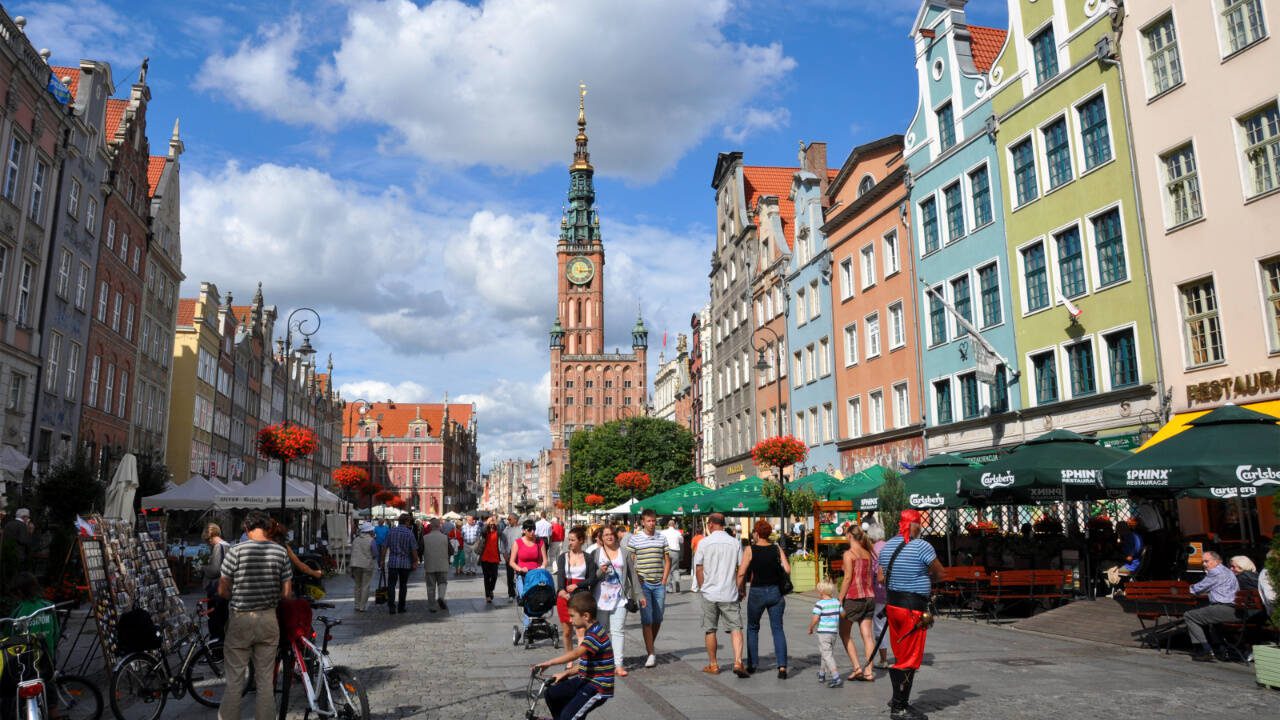Standing at the end of Gdańsk’s long wooden pier, I realize I can see two of the most important sites in 20th-century history: the spit of land where World War II began, and the shipyard where the Cold War started its long and gradual final act. Many people imagine this northern-Poland city to be a wasteland of rusted, smoke-belching shipyards. But visitors are surprised to enjoy a much different experience in what is one of Europe’s most underrated destinations. Gdańsk boasts both an illustrious history and one of the most picturesque old quarters in Eastern Europe — and it shows it off delightfully.
Gdańsk’s magnificent Main Town features block after block of red-brick churches and colorful, ornately decorated mansions. As one tourist gasped to me, “It’s like stepping into a Fabergé egg.” A stroll along the main drag, ulica Długa, allows you to soak in the city’s gorgeous architectural cancan. During the Golden Age, these eclectic homes (inspired by a wide range of people, including the Jews, Dutch, Italians and Germans) were taxed based on frontage, so they were built skinny and deep. The widest houses belonged to the super-elite.
This lovely street wasn’t always so lively and carefree. On Sept. 1, 1939, Adolf Hitler invaded this once-German city, sparking World War II. By the end of the war, nearly 80 percent of the city had been destroyed, and the main street was in ruins. Locals stubbornly rebuilt their town with the help of detailed drawings and photographs, using the original brick whenever possible. Today, excursion boats ferry history buffs through shipyards to Westerplatte point, where the war’s first shots were fired.
A short walk across town, you’ll find the Amber Museum, dedicated to the globby yellow stuff that’s sold all over the city. Almost 75 percent of the world’s amber — a fossilized tree resin — is mined in northern Poland, much of it washing up on beaches following winter storms. Visitors learn how amber comes in 300 distinct shades, from yellowish-white to yellowish-black, opaque to transparent. The museum shows off amber clocks, amber chandeliers, amber beer steins, a model ship with delicate amber sails. There’s even an unfinished altar made entirely of amber at St. Bridget’s Church.
If you’re interested in visiting a milk bar (bar mleczny), Bar Mleczny Neptun in the Main Town is the city’s most popular. Milk bars are government-subsidized cafeterias, a holdover from Poland’s communist days, when lowly workers could barely afford to eat out. Bar Mleczny Neptun has more charm than most milk bars, thanks to its outdoor seating along the most scenic stretch of the main drag. Load your tray with traditional Polish foods, such as borscht or pierogi, pay the cashier, and do a double take when you realize how little you spent. My bill for a full meal usually comes to about $5.
Just 20 minutes north of the Main Town, the charms of the old core fade quickly as you come across the Gdańsk Shipyard. Here, in the place that Solidarity leader Lech Wałęsa called the “cradle of freedom,” a motley collection of brave shipyard workers took on and ultimately ended the USSR’s stranglehold on Eastern Europe. In August 1980, a shipyard crane operator and known dissident was fired unceremoniously, sparking a strike. Upon hearing this news, Wałęsa — an electrician who had been fired for being an agitator — rushed to the shipyard and scaled the wall to get inside and rally the protesters.
Near the shipyard, the excellent museum inside the European Solidarity Center is Europe’s single best sight about the end of communism. It’s made even more powerful by its location — in the very heart of the place where those events occurred. Exhibits tell the inspiring story of those workers and the difficult communist reality they were struggling to change. You’ll see original plywood panels onto which the strikers scrawled their 21 demands, then lashed to the gate. Just beyond that, a giant video screen and a map illustrate how the strikes that began here spread quickly across Poland.
Four decades after the fall of communism, Gdańsk is, in many ways, a new city. Neighborhoods that the communists left as World War II rubble are now remade into posh condos and shopping malls, and a futuristic stadium shaped like a translucent glob of amber now houses the local soccer team. Despite modernization, Gdańsk will always have a powerful history. Exploring the lanes of this city, I always imagine that around each corner, I might bump into old Lech Wałęsa — now happily retired — still wandering the time-passed streets.
Edmonds resident Rick Steves (www.ricksteves.com) writes European guidebooks, hosts travel shows on public TV and radio, and organizes European tours. This column revisits some of Rick’s favorite places over the past two decades. You can email Rick at rick@ricksteves.com and follow his blog on Facebook.
Talk to us
> Give us your news tips.
> Send us a letter to the editor.
> More Herald contact information.

























